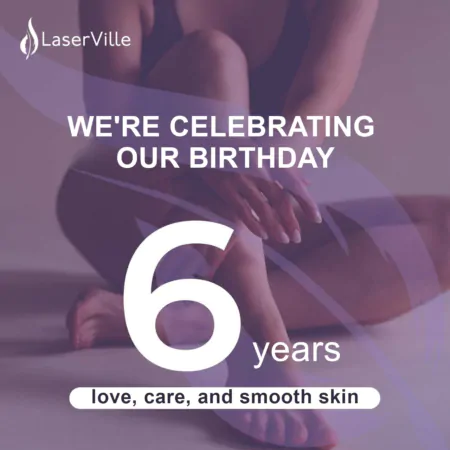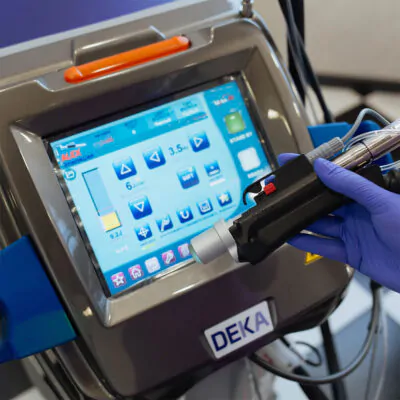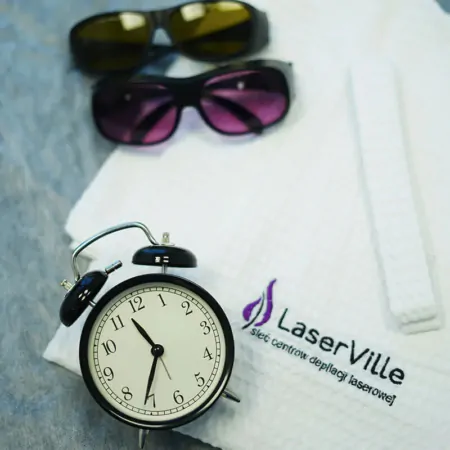Laser hair removal or photoepilation: what to choose?
Contents
In today’s fast-paced life, we try to minimize time-consuming tasks. Hair removal procedures are one such process that not only takes a lot of time but also money. We explain which hair removal methods are the most effective and help you understand the difference between laser hair removal and photoepilation. Find out what’s not worth paying for to save time for your favorite activities or relaxation.
Features of laser hair removal
LASER is an acronym for Light Amplification by Stimulated Emission of Radiation, which translates to “amplification of light by stimulated emission.” In other words, it’s a device that converts light, heat, or other types of energy into a focused stream of radiation.
Each type of laser—ruby, alexandrite, diode, and Nd
—has a wavelength strictly defined by the object it is named after and which is housed in the device:
- The wavelength of the ruby laser is strictly 694 nm;
- The alexandrite laser has a wavelength of 755 nm;
- The diode laser has a wavelength of 800 nm;
- The Nd:YAG laser has a wavelength of 1064 nm.

For example, ruby laser hair removal is most effective on the upper lip, while alexandrite and diode lasers are excellent for reaching the hair follicles of the chin, cheeks, shins, and thighs. Nd
is most effective for the “vegetation” in other body areas.
Another parameter affecting the effectiveness of hair follicle destruction is the degree of absorption of the wave by pigmented structures. That is, water, melanin, and oxyhemoglobin are influenced by the beam.
Since each laser has a narrow spectrum, each affects different structures. For example, the ruby laser, due to its short wavelength, is absorbed not only by melanin but also by the skin, which can cause burns. Therefore, it should not be used on dark or tanned skin. It is also ineffective for hair follicles located at great depths, such as on the legs, bikini area, and back.
Nd
laser hair removal is much weaker—its impact on pigment and skin is minimal, making it the safest for use on dark skin. However, its effectiveness is significantly lower, meaning more sessions are required. Another downside of Nd
equipment for hair removal is its high cost. Thus, if the salon does not offer other effective services, the client will end up spending a considerable amount.
Alexandrite and diode lasers are considered the most versatile, working on most skin phototypes without causing issues like pigmentation, burns, or other side effects.
Diode lasers absorb melanin and hemoglobin, destroying the growth zone from which the hair receives nourishment. This stops the supply of vital elements needed for hair growth, and after several sessions, the hair does not grow.
Procedures with diode lasers are most effective with combinations of light skin and dark hair. While the device is highly efficient, it often requires numbing of the treatment area. Pain sensitivity varies among patients. Additionally, there are already devices with cooling systems to prevent overheating of the skin.
Regarding the alexandrite laser—it is effective for various skin types, including African American skin. If the alexandrite laser has a built-in cooling system (like Motus AX), the epilation process is completely painless even at maximum settings.
The procedure’s technique also matters. Epilation in motion, patented by DEKA, allows for maximum but gradual heating of the melanin in the hair follicle. This eliminates pain while maintaining high effectiveness.
Features of photoepilation
Why are “laser photoepilators” often mentioned? After all, IPL photoepilation stands for Intense Pulsed Light?
Because, like laser hair removal, photoepilation is an optical procedure that works on the principle of selective thermolysis. Its essence is that light energy is absorbed by melanin, which gives color to the hair. After absorbing the energy, the pigment heats up, damaging the vessels that nourish the hair, the growth cells, and the skin.
However, compared to a laser epilator, a photoepilator has a broader flash while the laser beam is selective and does not affect surrounding tissues. The wavelength range of a photoepilator is from 500 to 1200 nm.
Initially, the IPL technique was used for removing vascular networks and moles. Over time, specialists noticed its effect on hair growth (or rather, its cessation). Interestingly, the first generation of IPL devices emitted UV rays harmful to the body. But over time, devices were equipped with filters that blocked them.
Additional filters allow for correcting various cosmetic defects such as pigment spots, scars, acne, and vascular stars. Therefore, modern photoepilation devices are used not only for hair removal but also for other cosmetic procedures.
The cost of a single photoepilation session is lower than that of laser epilation. However, due to the greater number of necessary photoepilation sessions, the total price is not much different from the cost of a laser epilation course.
 Contraindications for laser epilation
Contraindications for laser epilation
Contraindications vary depending on the type of laser. For example, procedures using a ruby laser, as mentioned earlier, are contraindicated for people with dark skin.
There are also general contraindications that are independent of the laser device.
First, these are absolute contraindications:
- photodermatoses;
- acute forms of skin diseases;
- any breaches of skin integrity;
- oncological diseases (for more details, see if epilation can cause cancer in the article);
- use of vitamin A-based medications;
- cardiovascular diseases;
- herpetic infections in the acute stage;
- excessive fresh tan;
- psoriasis;
- pregnancy and lactation.
And there are relative contraindications:
- allergic reactions;
- diabetes;
- varicose veins (for more details – in the material);
- use of psychotropic medications and herbs;
- retinoid therapy;
- use of blood-thinning medications.
Consult with your doctor to determine if the listed relative contraindications will allow you to undergo a course of laser epilation and achieve smooth skin.
Contraindications for photoepilation

As for contraindications, they include:
- previous heart attack or stroke;
- varicose veins in the removal area;
- neurological and psychiatric disorders;
- infectious diseases;
- oncological diseases;
- acute herpes forms;
- hormonal imbalances;
- photodermatosis;
- tan and self-tan;
- a large number of nevi (moles);
- allergy to sunlight;
- diabetes, asthma, hemophilia, HIV.
In the eye area, photoepilation is also strictly prohibited, as it can have negative consequences, including blindness.
Photoepilator or laser epilator: differences
The laser is a focused beam of light, while the photoepilator’s spot is widely scattered. The broadband light of the photoepilator reflects more off the surface of the skin. This means that the amount of energy that reaches the tissues is less, and accordingly, the effect of the procedure is weaker.
The radiation during photoepilation is polychromatic, encompassing the entire color spectrum and the direction of the rays diverging at different angles.
The laser is monochromatic, with a constant wavelength, and the direction of the beams is strictly parallel. Therefore, all the energy hits the “target” (melanin, hemoglobin) more precisely. The impact is targeted, with minimal energy loss. This means there is no effect on surrounding tissues, the frequency of side reactions is minimized, and the number of procedures is fewer.
With photoepilation, the spectrum of impact is broader, the penetrating ability is worse, and the likelihood of complications due to skin absorption increases.
Laser and photoepilator: the difference and what to choose?
Both methods of hair removal are based on the use of light. However, the effectiveness is unequivocally higher with laser devices.
Regarding specific indicators:
In terms of sensations. The pain of photoepilation is low. Laser – it depends on the type of equipment. Completely painless is the alexandrite laser with a built-in cooling system.
- Cost. One session of photoepilation is cheaper than laser, but due to lower effectiveness, the number of procedures per course is greater. For example, 6-8 laser procedures or 10-15 photoepilations.
- On the need for preliminary preparation. With photoepilation, the skin should not be tanned. It only works with skin phototypes 1-3 (fair). Laser hair removal on the Moveo – alexandrite laser from DEKA, allows reducing the restriction on tanning to 3 days (on diode – 10-14 days).
- Speed of the procedure. High speed on photoepilators, as the area of the impact spot is large. On diode and alexandrite – the procedure takes longer, but on the Motus AX, during motion epilation – it is the shortest. To increase speed, a special gel is used for the handpiece to glide over the skin.
- Effectiveness. Studies show that hair growth with photoepilators stops by 70%. Laser hair removal ensures the disappearance of “vegetation” by 80-90%.
- Safety. Laser epilators with cooling systems can be absolutely painless. Diode ones, where the power increases with each procedure, can be painful and require anesthetics (especially in highly sensitive areas). The photoepilator affects not only the hair but also the surrounding tissues, increasing the risk of side effects. Photoepilators are also not very painful.
Comparing the two methods with their advantages and disadvantages, and seeing the results of our laser hair removal salon, we confidently assert that the alexandrite laser is the safest and most effective way to remove unwanted hair. We hope we have clearly explained the difference between a photoepilator and a laser epilator, and you understand what you are paying for and how you are using your time.




 Contraindications for laser epilation
Contraindications for laser epilation In terms of sensations. The pain of photoepilation is low. Laser – it depends on the type of equipment. Completely painless is the alexandrite laser with a built-in cooling system.
In terms of sensations. The pain of photoepilation is low. Laser – it depends on the type of equipment. Completely painless is the alexandrite laser with a built-in cooling system.




























No reviews